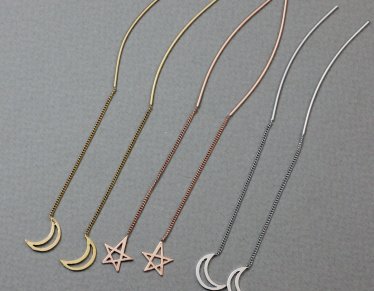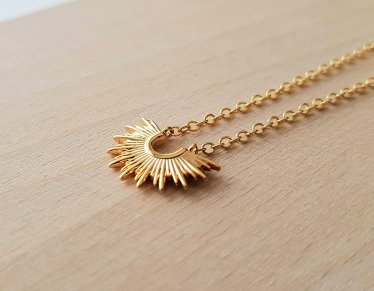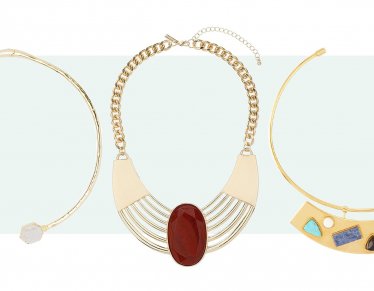Opal is one of the most common and versatile gemstones. One of the birthstones for the month of October (the other is rose quartz), it is not uncommon to see at least a piece or two of opal in every jewelry collection. Most opal comes from the white, blue, or green spectrums as these are the most common. Many black opal rings have a type of hybrid stone with a thin layer of gem-quality opal over a darker stone like onyx or obsidian. This is referred to by jewelers as an opal doublet. A significant portion of the budget-friendly opal pieces features opal doublet stones. Gemstone quality opal is made of opal all the way through. The price tag will often reflect this as well. We are big fans of both gemstone quality and opal doublets. For us, it is all about the look.
The opal is often cut in a cabochon style since opal, no matter the color family, is a solid stone. Light does not pass through opal as it would a clear stone like diamond, emerald, or sapphire. Spending time and effort on round brilliant cuts of opal will not increase the wow factor. For this reason, most opal pieces feature a smooth, rounded face. Designed to expose as much of the brilliant play of color as possible, this is the best way to highlight the natural beauty of opal.
The rarest form of opal is black opal. Much of the world’s black opal comes from Australia where geological conditions are just perfect for form the richly colored stone flecked with fiery pops of color. Natural black opal can be more expensive than diamonds because it is so rare. While diamonds are much harder to mine, naturally formed opal needs conditions more specific than diamonds so not as much of it has formed.
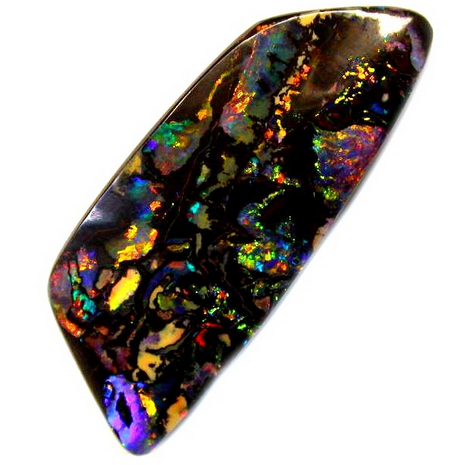
Luckily the chemical makeup of opal is easy to produce in a lab. Lab-created stones are gaining traction in the jewelry community. First, because they are significantly cheaper. No one has to find, mine and refine the stone to make it ready for a jeweler’s touch. Second, lab-created stones are always conflict-free. No one need to worry about how the stone was produced. It is all clearly documented. Finally, lab-created stones can be closely controlled whereas nature cannot be at all.
Finding a black opal that has naturally formed is only the first step. It then must be cut and polished and the most beautiful, colorful parts preserved. Black opal, as well as its close cousin fiery opal, are fantastic candidates for lab creation. In the lab, each stone is carefully cultivated to be just as beautiful and fiery as every other stone. Colors also tend to be richer and more varied in lab-created stones. Many of the black opal rings on our list feature lab-created black opal for this reason.
Our 10 Favorite Black Opal Rings!
1. Black Opal Venetian Ring

The first ring on our list combined lab-created black opal with cubic zirconia and 925 sterling silver. It looks rich without the rich price tag.
Venetian style black opal rings are a fairly new style of ring. Introduced by jewelry giants, Verragio, their Venetian line was most notable for the lacy gold work in the bands and settings. The metal was delicately shaped to leave open, negative space much like a piece of delicately woven lace.
This ring builds from that concept. The seven millimeters black opal cabochon is boldly set in four prongs. The sterling silver is gently cut on the sides and below the setting into a lacy pattern. Two cubic zirconia stones grace each side of the ring.
This ring, because of the Venetian styling, will have a significant elevation off the finger. The added height of the sculpted silver only serves to highlight the depth and dimension of the lab-created black opal.
We love the inspiration for this piece. We love the price tag even more. Simply put, this is a must-have ring for the price.
2. Natural Black Opal Cocktail Ring
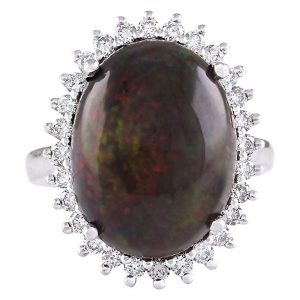
This black opal cocktail ring is the only ring on our list to feature a natural black opal. And feature the rare stone it does. Made by Fashion Strada, the creators take a sizable chunk of the rarest opal and fashion into a cocktail ring. Then, as if the sizable cabochon of black opal weren’t enough, the surround it with a ring of white diamonds. Altogether, this ring carries shocking 8.66 carats in stones alone. These are set in 14k gold in your choice of yellow, white, or fashion-forward rose gold. The whole affair is then custom sized.
The price tag is steep but it is a lot of black opal rings and a lot of natural black opal. The natural opal is far more subtle in its beautiful coloration but no less beautiful. To be honest we can not think of a better style of ring for a black opal of this size than a cocktail ring.
Cocktail rings are the statement pieces of the ring genre. They made their debut into fashion jewelry in the 1920s. Like most other things of the era, the innovators of this ring style wanted to create something big and boisterous.
The decade was marked most notably by Prohibition, a series of law making the production, sale, and consumption of alcohol for recreational purchases illegal. The stringent laws led to quiet, underground bars known as speakeasies to pop up. These illegal establishments welcomed men and women who wished to imbibe. Prior to this woman of reputation were rarely seen in bars or drinking establishments. But the Roarin’ Twenties saw flappers, women’s suffrage and a rise in women expressing themselves through bold style. In this movement, the cocktail ring was created. Large, almost overwhelming rings designed to draw attention for the sake of attention. Oversized stones, bejeweled figures, and brightly colored enamel rings were all the rage.
We still love the cocktail ring today. Just like those flappers, statement pieces are a must-have in every jewelry type.
3. Princess-Cut Black Opal Solitaire Ring

The princess cut for gems and stones is a fairly recent creation in the jewelry world. Introduced in the 1960s it is now one of the most popular cuts for a diamond, gem, or semiprecious stone. The square princess cut is second only to the classic round brilliant cut. Jewelers and jewelry lovers alike have come to prefer the princess cut in the last two decades. This is because there are fewer actual cuts needed to create a sparkling effect. More than three-quarters of the stone is left untouched.
We feel this cut is absolutely perfect for the lab-created black opal. With so many fiery colors, the inverted pyramid shape and gently rounded edges of the princess cut really highlight the beauty of the stone. Since much of the interior of the stone is left intact, all the lovely colors of the stone will shine brightly from the facets while maintaining a nice weight on the finger.
This ring features six diamonds laid into the side of the 14k white gold ring. These round brilliant cut diamonds, the close cousin of the princess cut of the black opal centerpiece, are IJ in color and I1 for clarity. All six stones total .03 carat so they are not the star of the show. They do add a gorgeous glint to the deep rainbow of the eight millimeters by eight millimeters black opal.
4. Black Opal Claddagh Ring
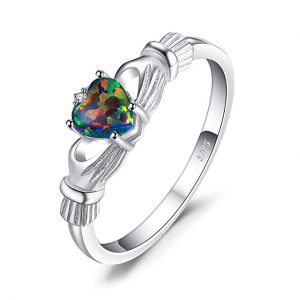
The Claddagh Ring is an absolute classic and we can’t get enough of it. Two hands of 925 Sterling Silver, representing friendship, come together to grasp a stunning lab-created black opal stone cut into the shape of a heart. This shape symbolizes love. The rich variation of deep colors in the black opal grant gives this ring a stunning, eye-catching look. In place of the traditional crown atop the heart, a subtle crystal stone perches, representing loyalty. When paired with the black opal, it provides a wonderful contrast of light and dark.
Rich with symbolism this is a perfect gift for friends or romantic partners. The traditional Irish representation of love, friendship, and loyalty, how it is worn determines whether the relationship it celebrates is one of romantic love or platonic love. It can also indicate the level of the relationship. Wear this beautiful Claddagh ring with on the right hand with the bottom of the heart pointed toward the fingertips and it means you are single and hoping to find that special someone.
This can also mean you are wearing it as a symbol of friendship as opposed to romance. If you are in a relationship turn the ring around so the heart points toward your wrist. Move it over to the left and it represents a long-term commitment of either betrothal or marriage. The heart should point toward the fingertips for an engagement. Once you are wed, flip it around to point toward the wrist.
The ring style originated in Galway, Ireland in the seventeenth century. It is a part of a surprisingly large family of jewelry feature hands hold a stone. These are known as fede rings. Its popularity has grown exponentially, especially in the twentieth century. It is a celebrated piece of Irish American culture. We adore this incredibly priced black opal piece. We know you will too!
5. Black Opal Cabochon Sterling Silver Ring
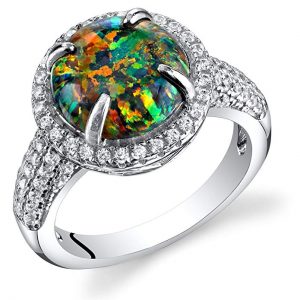
The remarkably reasonably priced black opal cabochon ring is one of our favorites on this list. The lab-created stone measures a full 10mm and 1.5 carats. The cabochon cut is held by 4 prong mount in 925 Sterling Silver It is haloed by seventy-two cubic zirconia. This marvel of science and gemology cannot help but sparkle. Enigmatic by nature, perfected by science, the black opal is perfectly offset by the bright shine of the cubic zirconia. The gems cascade down the sides, otherwise known as the shoulders, of the ring as well.
A ring’s anatomy is important to understand when shopping for jewelry. This particular ring has a lot going on. The sides of the ring that feature more of those gorgeous cubic zirconia are referred to by jewelry designers as shoulders. Stones mounted there are called side stones. The star of the setting, in this case, the black opal, is called the feature stone.
The accompanying stones, if any, are set in the gemstone stations. For this ring, it is in a halo arrangement. Under the stone, the part of the ring that sits on your finger is known as the gallery. For most black opal rings, this leaves room for the bottom portion of the feature stone or the structural work to support all the stones.
6. Black Opal Love Knot Ring
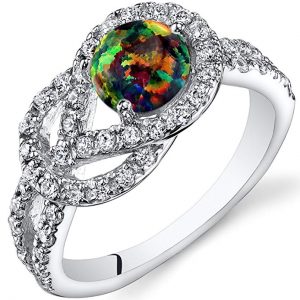
This is the second ring on our list featuring a darling Celtic symbol. Although the lover’s knot is by far the simpler of the imagery, it is no less poignant. We adore this take on the lover’s knot featuring a lab-created black opal cabochon.
The lover’s knot is a traditional piece of Celtic knotwork. In its original form, it is two continuous strands, or ropes, intertwined in a form reminiscent of a heart. Because both these strands have no beginning and no end, they represent the eternal love each has for the other. As both strands are eternally entangled, they symbolize how connected life, love and eternity are.
Celtic knots have long been a popular feature in jewelry and in particular rings. Going as far back 450 Common Era (formerly called 450 AD), and perhaps even earlier than that, the Celtic knot is found on art and manuscripts dealing with a variety of topics. The lover’s knot is most present on pieces referring to romantic coupling, betrothal, and marriage. Because of this, the lover’s knot is a popular choice for promise rings, engagement rings, wedding rings, and anniversary rings.
While the Celtic version of the lover’s knot is more complex, the jeweler’s love knot is two simple loops connected by the feature stone. This black opal feature stone is enshrined by cubic zirconia set in both portions of the lover’s knot loops. It makes this ring the perfect anytime gift for that special lady, both beautiful and meaningful.
7. Men’s Tungsten Carbide Band
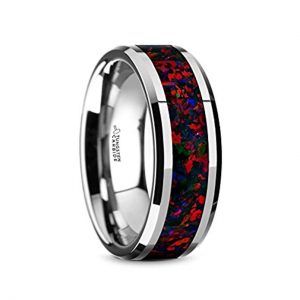
The first of our men’s selection on this list, we love the simplicity of this black opal tungsten carbide ring. A band of lab-created black opal is laid flush in a smooth band of tungsten carbide for a sleek, refined ring. This ring design creates a striped effect with the brilliant black opal flanked by two shining ribbons of polished metal.
Tungsten carbide is known for its strength. Composed chemically of equal parts of tungsten and carbon, the metal is durable and scratch-resistant. A popular choice for men’s bands, it can deal with wear and tear for gentlemen who have a hands-on type career. For this design, the stone is flush with the band so there is nothing to snag or hang. This limits the opportunity for damage to both the ring and its wearer.
Black opal rings of this design are very popular choices for wedding bands. Adding the exotic looking black opal to the design brings it to the next level for us. The bright tungsten pairs wonderfully with the deep colors of the opal. The brave couple would adopt this wonderfully priced piece as a part of their wedding set. Pair it with one of the lady’s choices above as an engagement for a wonderfully unique matched set. We recommend the Love Knot or the Claddagh, combining the unique look of the stone with the wonderful symbolism.
Additionally, just because it is marketed as a men’s ring, does not mean women should pass it up. We believe it would be a wonderful adornment on a lady’s hand as well. For those women who do not prefer the bulkiness or height of more traditional women’s rings, this is the perfect way to wear black opal. It would make a great gift for women who work in the medical field, childcare and senior care providers, moms with young children, and ladies with more subdued tastes.
8. Men’s Godfather Ring
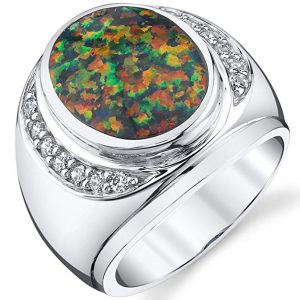
The word opal is believed to derive from the Sanskrit word, upala, meaning precious stone. The low profile setting in this Men’s Godfather ring is certainly a wonderful way to display this particular precious stone.
The godfather style ring started far less ominous than the name might suggest. Dating back to first-century Rome, famous historian Pliny the Elder wrote about men wearing rings on their fifth finger. Fifth finger rings, or pinky rings, continued through the ages. Originally just a simple band, it began to evolve into more complex fashions including precious and semiprecious stones set in a row. No feature stones were included in the original fashion. The earliest documentation of these indicates that wearing a pinky ring might indicate the wearer was not only unmarried but uninterested in the institution.
However, by the nineteenth century in the Edwardian era, as feature stones became more fashionable, men’s jewelry followed suit. Signet rings entered the fashion lexicon and quickly replaced the simpler bands. Many of these early versions were a sign of a professional or academic association. Famous men including members of the British Royal Family and President Franklin Delano Roosevelt wore signet rings on their left pinky. In fact, President Roosevelt’s was so notable Sir Winston Churchill even commented on it during one of the meetings in World War II. Signet black opal rings featured mounted stones of all varieties as well as enamel and metalwork seals, symbols and letters, depending on their purpose and origin.
In the mid-twentieth century, the signet ring became associated with criminals and the seedy underbelly. No one is quite sure how, though. The movie The Godfather permanently linked this association and the signet ring worn on the pinky became forever labeled the godfather ring.
Luckily, this godfather ring can be worn even if you live a crime-free life. The lab-created black opal cabochon is flush mounted within 925 sterling silver. Fourteen machines cut cubic zirconia paints the edges with a bit of sparkle. This ring is perfect for the man with more classic tastes in your life. In keeping with the essence of the ring style, it is best worn on the left pinky if unmarried.
If the wearer is married and does not prefer to wear a ring next to his wedding band, the right hand is perfectly acceptable, as is any finger. Wear this ring wherever it feels comfortable and it will look as handsome as it will anywhere! This ring is a fantastic choice for your grandfather with the very classic cut and the history of the pinky ring.
9. Men’s Black Opal Knight Ring
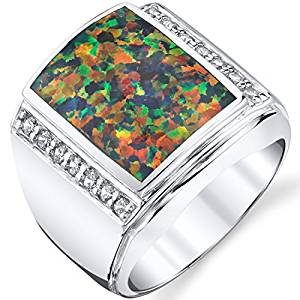
Knight rings have an origin story almost as long as written history itself. Traditionally knight rings were family rings. They got the name because most common people lacked the money or resources to make such a treasure. Only men who were knighted held positions of power or courtiers had the expendable cash to make body adornments like rings.
The knight rings may have featured a family heirloom jewel. More often than not that jewel was not a precious stone. If it was a precious stone it was likely one native to the region rather than an exotic or imported stone from a faraway land. In medieval times, family wealth was determined by how much actual treasure, cash, and land was held. Rings became a popular way to secure and claim ownership. By mounting a valuable stone in a ring adorned with your family’s crest or name, it became indisputable who laid claim to its value. These rings were often passed down from father to son as were the titles and, depending on the society, the knighthood.
The term knight ring rose to popularity in the medieval period as knights began to forego the stones in favor of the seals or emblems of their order. Alternatively, they might have a ring created to pledge fealty to a certain throne. Since there were many kings and kingdoms the rose and fell from power rather quickly in this period, a lot of rings were cast and recast. Not including a stone meant a ring could be easily reformed if the knight or his kin had to switch allegiances after the fall or death of a reigning monarch. These were rare rings, however. Many of the knights rings still in existence signify the order the knight belonged to. Most famous among these were the Knights Templar.
As warrior knights and the serfdom that supported them fell out of fashion in the 16th and 17th century, knight rings became more popular as a sign of the title rather than the job. Most importantly, feature stones began to reappear. This time they could be any stone and precious stones like ruby, emerald and sapphire were heavily favored. Sometimes additional information was carved into the shoulders of the ring. Organizations such as the Freemasons also adopted the wide use of knight black opal rings.
This knight ring features the lab-created black opal of course. The shoulders are adorned with eight cubic zirconia stones, four on each side in a geometric diamond shape. Compared to the knight’s rings of old this one is understated and simple. But by no means does the simplicity detract from the elegance of this handsome piece. The is perfect for any man of any tastes. Everyone wants to feel like royalty and this black opal knight ring goes a long way to helping create that!
10. Men’s Black Opal Aston
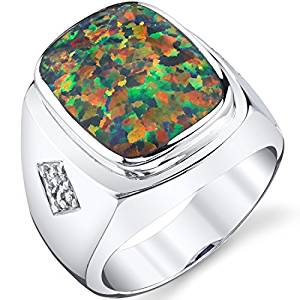
The final entry on our list is a classically styled Aston Ring. Aston black opal rings most often feature a rectangular feature stone and this one is no exception. The exceptional part of this design is the large black opal the makers chose. The broad, rectangular stone gives a lot of surface area for the alluring colors to really glint and shine. Two columns of cubic zirconia flank the black opal and complete the look. All set in 925 Sterling silver, this ring is perfect for Father’s Day or as a graduation gift. The price is right as well for a man just starting his own collection. It is a great ring to add a unique flash of color to the stash. We think this style of ring is great for everyday wear. No need to reserve this one for special occasions.
It should be noted that mother of pearl, an opalescent material, is sometimes substituted for opal. Mother of pearl is the iridescent lining of oyster shells. While it is beautiful, it is not the same as opal, a geologic creation. It is a biological creation and not related to opal. When shopping around for opal, especially green and black opal, be sure to read the fine print and confirm you are receiving the stone you are looking for. Luckily, this is not the case for the black opal rings our list, even the natural black opal we found.

